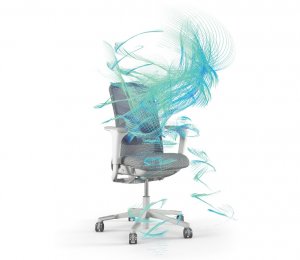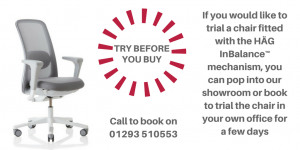On National Stress Awareness Day, we take a look at the importance of workplace design and ergonomics on the reduction of employee stress, fatigue, illness and absenteeism.
According to Beautyman (2006), businesses that ignore the design and layout of their workplaces are failing to optimise the full value of their human capital. This is echoed by Amble (2005) who points out that poor workplace design is linked to lower business performance and a higher level of stress experienced by employees.
Research by the Industrial Society in London suggests that many employers are beginning to take notice of the impact of stress on their businesses and see it as a matter of urgency to improve their employee's working environments. 74% of surveyed employers predicted that employee stress would become their greatest health and safety concern in the next few years, with 53% stating that this is an issue which employers should address proactively.
With this in mind, what is it that can be done to create a comfortable, productive working environment that provides a reliable ROI?
Looking at the balance of privacy and co-working spaces is a good place to start in catering to an array of personality types, fluctuations in employee moods and the levels of productivity required from employees. According to Monroe (1999), physical environments that foster creativity and interaction, whether in conference areas or in "casual collisions" in corridors or break areas, is important for building rapport and support networks, as well as improving communication and problem solving. Following on from this, Asirvatham (1999) and Umlauf-Garneau (2001), predicted that future offices will consist of very few fixed walls and will see an increase in mobile furniture, more laptops and a generous distribution of data and power outlets, allowing employees to choose their working space in order to reach their maximum productivity.
So, how is a well balanced workplace design that caters to a range of personalities and requirements reached?
Wallace (2001) predicted that the office cubicle will not be something that we see disappear, but instead, redesigned to reach a concept that allows for better acoustics and accessibility, leaving the onus for creating complete privacy on separate sound proofed rooms available for access on an as-and-when-basis. A good example of the type of "cubicle" that has been redesigned for the modern office is the Den range sold on our website. Available in a range of shapes and sizes and with great acoustics, Den is a flexible and dynamic solution to the classic, more restrictive cubicle.
With this in mind, it is important to also factor in parts of office design that aren't always immediately obvious, such as aforementioned acoustics and types of lighting. Hower (1995), reports that high noise levels can cause irritation, increase stress and reduce productivity, whilst Smith (2001) reported that employees who are constantly working in a noisy environment show higher levels of adrenaline which, in turn, decreases their productivity and in some cases adds to absenteeism.
Frank (2000) points out that lighting is a critical element in creating a comfortable working environment and that lower lighting levels, rather than fluorescent tubing, boosts productivity, although in these situations employees should be provided with individual task lighting which can be adjusted accordingly. Hower (1995), explains why lighting has such an impact on productivity with light levels affecting the endocrine system, cardiac rhythm and "the body clock". He goes on to add that lower levels of lighting increase memory function and focus, whilst daylight improves mood. According to a survey by Steelcase Workplace Index, 86% of participants stated that poor lighting caused them some form of discomfort i.e, headaches and watery eyes. According to the same survey, proper lighting would increase efficiency for 3 out of 4 of the participants.
Lighting and acoustics, whilst essential in achieving a good ROI from your office refurbishment, are tricky areas of office design to get right. It is best to consult with your designer early on in the process in order to get these fundamentals correct from the start.
Now we've covered some of the larger aspects of a productive workplace, let's cover one of the essentials which is often over looked - ergonomics.
According to the Work Related Musculoskeletal Disorder Statistics (WRMSD) report by HSE for Great Britain 2016, the total number of WRMSDs in 2015/16 was 539,000 out of a total 1,311,000 for all work related illnesses, a total of 41%. An estimated 8.8 million working days were lost to WRMSDs, making an average of 16 sick days per case. A breakdown of the total days lost to WRMSDs shows that 36% were due to upper limb disorders, 39% to problems with the back and 26% to lower limb disorders.
These sick days put a huge strain on a company's productivity and financially they take a toll with paid sick leave and any healthcare costs if included in an employee's benefit package. However, many of these cases can be avoided with investment in a simple ergonomics program. Offering staff the right ergonomics equipment such as a height adjustable desk, ergonomic chair and other accessories such as wrist rests can seem like a costly outlay. In many cases though, when the cost of sick days and health care and the decline in productivity is calculated against the cost of this equipment - much of which lasts for many years - it actually presents a huge saving. It's not just in preventing the sick days that ergonomics can help boost productivity either. Proper ergonomics can boost concentration, memory and mood which helps to make the employee more efficient during their working day.
If you are confused as to where to start with ergonomics, you can find an array of videos on our website to help you adjust your existing chair or guide you in choosing a new chair to suit your needs. We also offer a range of desks and accessories which all fit within a good ergonomics strategy for your business. With over 20 year's experience our advisors can help you to choose the right furniture for you ergonomics plan, as well as designing your office to help you get the most out of your staff and your investment in your workplace.
[yikes-mailchimp form="1" title="1" description="1" submit="Sign Up"]


